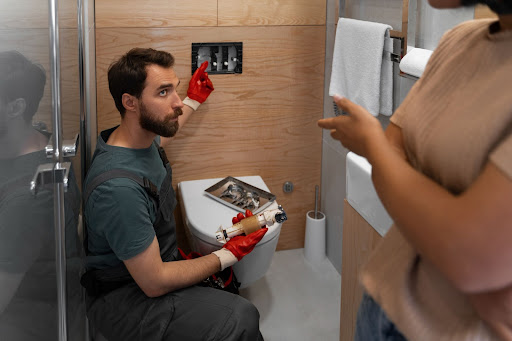Your bathroom is one of the most essential parts of your home. It’s where you start and end your day, and it plays a crucial role in maintaining your overall well-being. However, the plumbing in your bathroom is often overlooked until something goes wrong. Neglecting bathroom plumbing issues can lead to water damage, higher utility bills, and other costly problems. In this blog post, we’ll explore the five key signs that indicate it’s time to replace your bathroom plumbing to ensure your bathroom remains functional, efficient, and safe.
5 Signs to Replace Your Bathroom Plumbing
- Persistent Leaks
One of the most obvious signs that your bathroom plumbing needs replacement is the presence of persistent leaks. Leaks can occur in various places, including faucets, showerheads, pipes, and toilets. While a minor drip may seem insignificant, it can lead to more significant issues over time. Here’s what to look out for:
- Faucet and Shower Head Leaks: If you notice that your faucet or shower head constantly drips even after tightening the fixtures, it may be time for a replacement. These leaks can lead to increased water bills and water damage to your bathroom fixtures.
- Pipe Leaks: Leaks in your bathroom pipes can be challenging to detect, but they can cause substantial damage to your home over time. Look for water stains on walls, ceilings, or floors, as well as mold and mildew growth, which are signs of hidden pipe leaks.
- Toilet Leaks: Toilets are common sources of leaks, with water escaping from the tank into the bowl, or worse, onto your bathroom floor. A leaking toilet can waste a significant amount of water and lead to structural damage.
If you notice any of these leaks, it’s essential to address them promptly to prevent further damage and water wastage. Replacing the affected plumbing components may be the most effective solution.
- Reduced Water Pressure
Have you noticed a significant decrease in water pressure when you turn on your bathroom fixtures? Reduced water pressure can be a sign of several plumbing issues that require attention:
- Clogged Pipes: Over time, mineral deposits, debris, and rust can accumulate in your bathroom pipes, causing blockages that reduce water flow. If cleaning the pipes doesn’t restore proper water pressure, it may be time for replacement.
- Corroded Pipes: Corrosion can deteriorate your pipes, leading to leaks and reduced water pressure. If you have older plumbing with visible signs of rust, it’s best to replace the corroded sections or the entire system.
- Pipe Erosion: In some cases, pipes may erode, leading to reduced water pressure and potential leaks. If you notice a decrease in water pressure accompanied by rusty water or discolored water, it’s a strong indication that your plumbing needs replacement.
Restoring proper water pressure is crucial for a comfortable and functional bathroom. Replacing corroded, clogged, or eroded pipes will not only improve water flow but also prevent potential plumbing emergencies.
- Strange Noises
Unusual sounds coming from your bathroom plumbing can be a clear indicator that something is amiss. While some sounds may be minor and harmless, others can signal more significant issues:
- Gurgling Drains: If your bathroom drains gurgles or makes strange noises when water is draining, it could be a sign of clogged or damaged pipes. The gurgling sound is often due to air trapped in the pipes, which can lead to slow drainage or backup.
- Banging Pipes: If you hear loud banging or knocking noises when you use the bathroom fixtures, this could be a result of a water hammer. Water hammer occurs when water abruptly stops or changes direction in the pipes, causing stress and potential damage to the plumbing system.
- Whistling or Hissing Sounds: Whistling or hissing sounds can indicate issues with the water pressure or a malfunctioning valve. Such sounds can be a nuisance and may lead to more significant plumbing problems if not addressed.
If you experience any of these sounds, it’s important to consult a professional plumber to diagnose the issue accurately and determine if replacement is necessary.
- Aging Plumbing
The age of your bathroom plumbing plays a significant role in its reliability and efficiency. If your home has older plumbing systems, it’s essential to be aware of the signs of wear and tear:
- Deteriorating Materials: Older plumbing materials, such as galvanized steel or polybutylene pipes, are prone to corrosion, rust, and leaks. If your bathroom plumbing is made from such materials, it may be time to consider a complete replacement with more durable and reliable options like copper or PEX.
- Frequent Repairs: If you find yourself frequently calling a plumber to fix various issues in your bathroom, it’s a clear sign that your plumbing is reaching the end of its lifespan. Frequent repairs can be more costly in the long run than investing in a complete plumbing replacement.
- Outdated Fixtures: In addition to the pipes, consider the age and condition of your bathroom fixtures. Old faucets, toilets, and showerheads may not function efficiently and could be contributing to water wastage and high utility bills.
Upgrading your bathroom plumbing to modern, high-quality materials and fixtures can improve water efficiency, reduce maintenance costs, and enhance the overall functionality and aesthetics of your bathroom.
- Foul Odors
Unpleasant odors in your bathroom can be more than just a nuisance; they may indicate plumbing problems that need attention:
- Sewer Odors: If you detect the smell of sewer gas in your bathroom, it’s a sign of a plumbing issue. Sewer gas can be harmful to your health and may be entering your bathroom through damaged or malfunctioning plumbing.
- Mold and Mildew Odors: Mold and mildew growth often occur in damp and humid environments, and plumbing leaks or poor ventilation can contribute to this problem. The musty odors from mold and mildew are not only unpleasant but can also affect your indoor air quality.
To address foul odors in your bathroom, it’s crucial to identify and resolve the underlying plumbing issues. This may involve replacing damaged or deteriorated pipes, improving ventilation, or installing proper traps and seals to prevent sewer gas from entering your home.
Bathroom Plumbing Replacement with Tap 2 Drain Plumbing
Your bathroom is an essential part of your daily routine, and its plumbing is vital for your comfort and well-being. While plumbing replacement may seem like a significant investment, it can prevent costly water damage, reduce utility bills, and improve the overall functionality and aesthetics of your bathroom.
Don’t wait until a minor plumbing issue turns into a major problem; consult a professional plumber at Tap 2 Drain Plumbing to assess your bathroom’s plumbing and address any necessary replacements. Your bathroom will thank you with years of trouble-free service.

